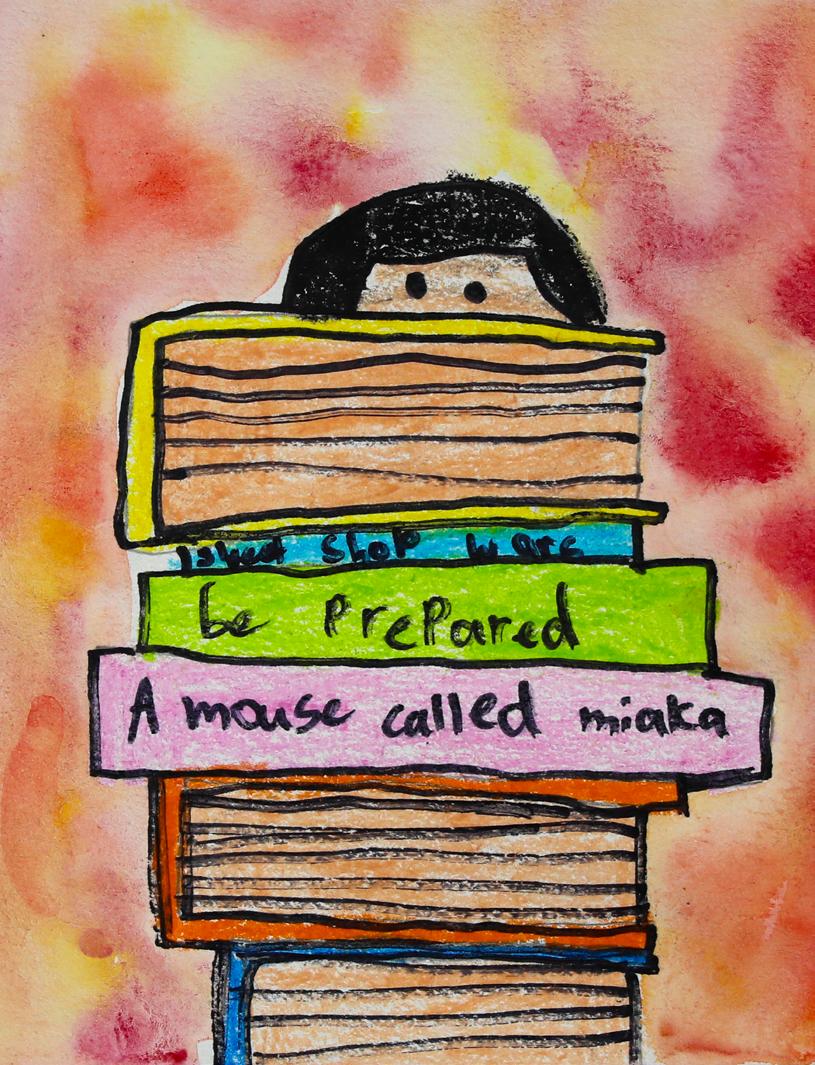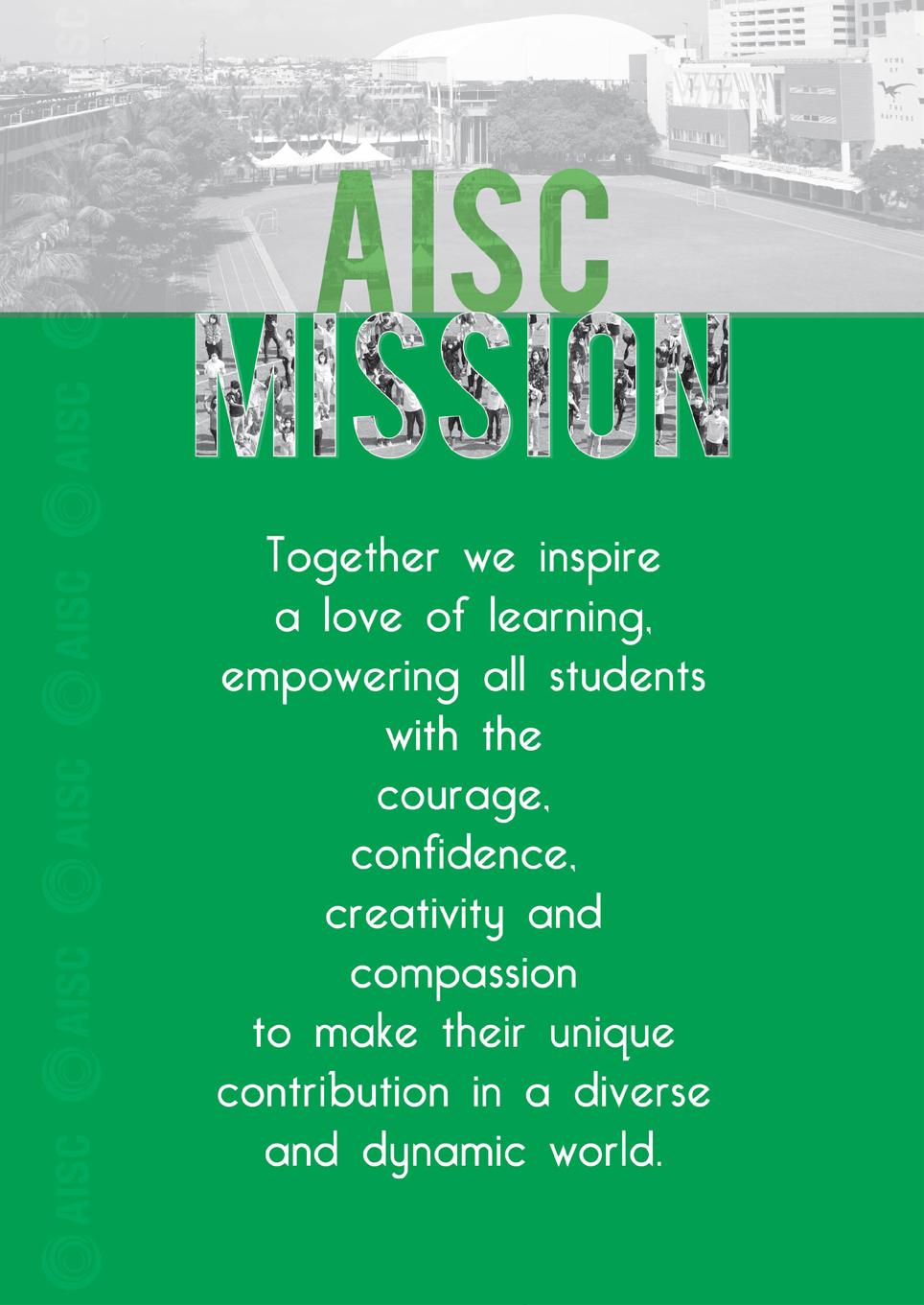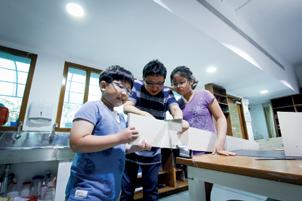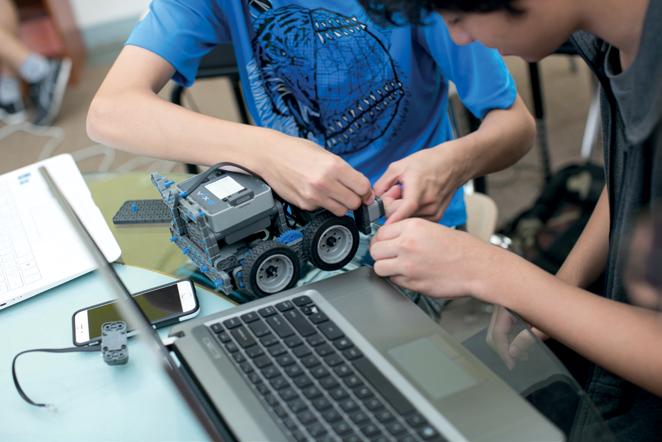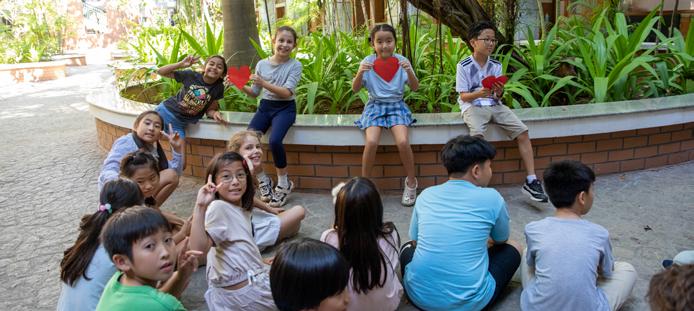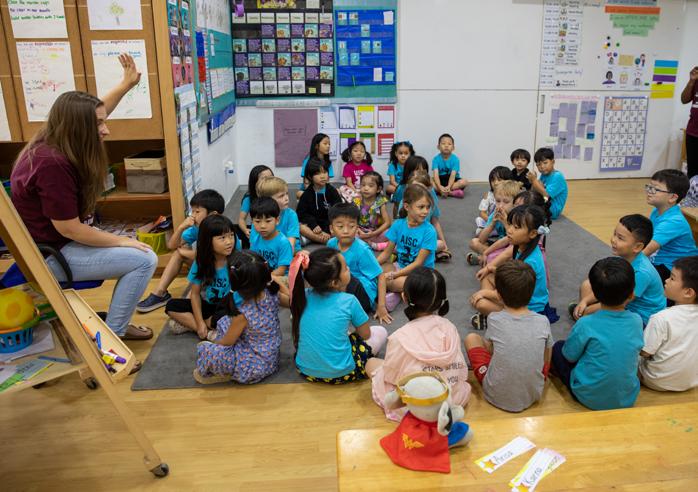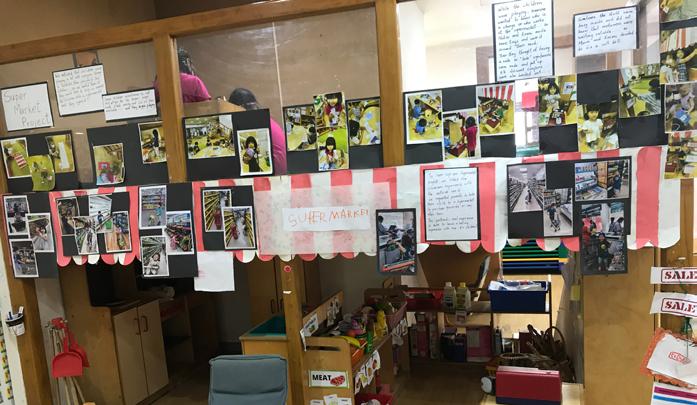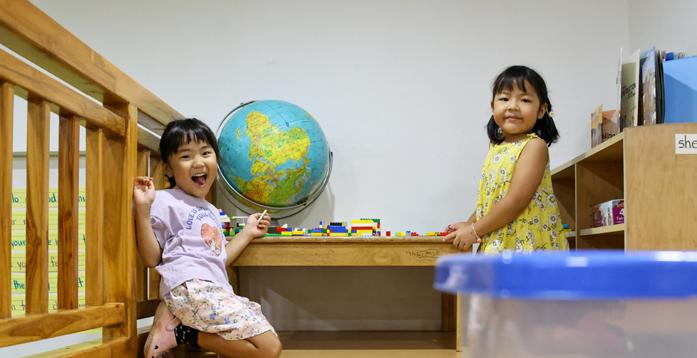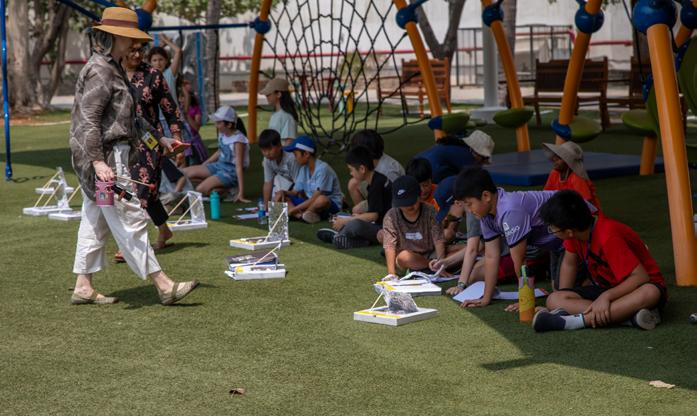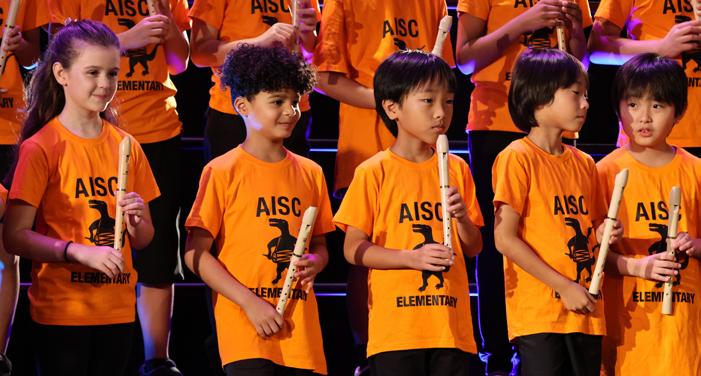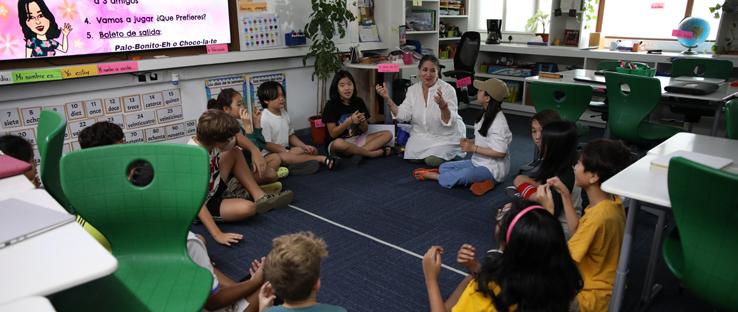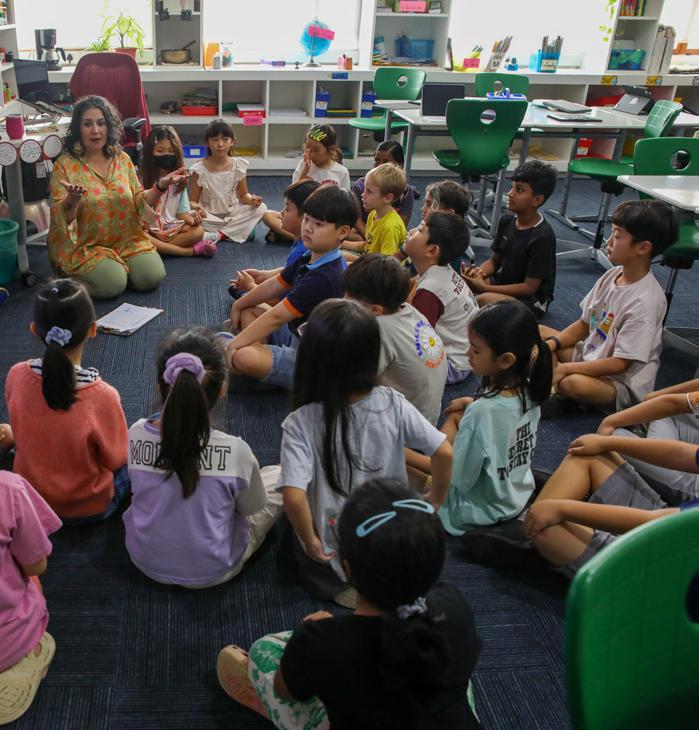LEARNING
Counseling
Our Elementary Counseling Program is designed to support the holistic development of students from Early Years through Grade 5. Grounded in the International School Counseling Association (ISCA) standards, our program focuses on fostering social-emotional learning, enhancing self-awareness, and promoting positive interpersonal relationships. Through a variety of engaging activities and lessons, our counselors work collaboratively with students, teachers, and parents, to create a supportive and inclusive environment. Our goal is to empower students with the skills and strategies they need to navigate challenges, build resilience, and thrive both academically and personally. We are committed to nurturing each child’s emotional wellbeing and fostering a strong foundation for lifelong learning and success.
Responsive Classroom
The Elementary School utilizes an educational approach to building collaborative communities called Responsive Classroom. Responsive Classroom is a studentcentered, social and emotional learning approach to teaching and discipline. It is a set of research and evidence-based practices designed to create safe, joyful, and engaging classroom and school communities for both students and teachers. The emphasis is on helping students develop their academic, social, and emotional skills in a learning environment that is developmentally responsive to their strengths and needs. The Morning Meeting is one practice of Responsive Classroom that all Elementary students participate in daily. There
Elementary School Curriculum Guide 2024 - 2025
are four components of the Morning Meeting. These components include the greeting, sharing, group activity and a morning message to help welcome students into the class, build community and prepare students for the day of learning.
EARLY YEARS ENVIRONMENT AND CURRICULUM
Children learn best through active exploration in an environment which is rich in materials and opportunities to interact, work, and play. At AISC, we create those opportunities to support and extend children’s cognitive growth, interpersonal skills, kinesthetic learning, and social and emotional development through play.
We believe children learn best when provided with opportunities to engage in activities that inspire curiosity and thinking. Teachers facilitate learning experiences that encourage children to pursue their independent interests, make deep connections, and extend their knowledge. Because we believe that each child is a unique individual, our Early Years Program provides inclusive settings that recognize children’s varied abilities, interests, needs, and learning styles.
AISC values the diversity within our community and we intentionally work to build strong partnerships between home and school.
Multi-Age
We offer a multi-age program for three- and four-year olds. We believe there are strong benefits for both three- and four-year old children being together in the same classrooms. Our multi-age classrooms provide younger and older children opportunities to develop a sense of social belonging and interdependency. Younger children gain a sense of security being with older children, and they engage in more complex and interactive social play. Younger children also are more likely to mirror the language and problem-solving skills of their older
age peers. Spending time with their younger age peers, older children gain an increased sense of confidence about their own skills. They also exhibit more sharing, explaining, and nurturing behaviors as well as take on leadership roles in the classroom. Multi-age classrooms in Early Years allow children to develop and grow at their own pace while promoting their strengths and supporting their individual needs.
Outdoor Learning Center (OLC)
Directly behind the Early Years classrooms, along the eastern wall of our AISC campus, is our Outdoor Learning Center (OLC). This area is a continuation of the Early Years classrooms and is considered a learning environment first, and a recess space second. Children from Early Years and Kindergarten enjoy this space throughout their day and are exposed to numerous opportunities to enhance their development and engage in big body play such as running, jumping, balancing, throwing, and catching. Children might explore the grassy mounds, crawl through the tunnels, make mud pies in the mud kitchen, ride on tricycles, or play in the sand.
Learning through Play
As young children grow and develop they are continually exploring the world around them. They form ideas about how things work, they learn the names of different objects and actions, and they begin to relate to other children and adults. Based on years of research, we know play is the predominant way of how children learn and make connections in early childhood. With their imagination, they immerse themselves in play by testing out their ideas as they move objects around, build structures, draw and write out images and words in their mind, look at pictures and words in books, act out different roles in pretend play, count items, learn to understand their feelings and the feelings of others, and make friends. Play not only allows children’s ideas and interests to come alive in imaginary and real ways, but is foundational to how children grow and develop in these early years.
Emergent Curriculum
An emergent curriculum fosters children’s ideas and integrates their learning across different developmental areas. Teachers guide children’s learning as they explore, discover, and create. The classroom and Outdoor Learning Center play a pivotal role in how teachers set up those environments to
promote opportunities and intentionally build off of children’s ideas and explorations. Teachers engage children in projects that promote language, early literacy, early numeracy, physical and social-emotional development. Through systematic planning and review of documentation, teachers model and scaffold to enhance children’s learning. Teachers carefully listen to and observe children during play. Teachers reflect on what they see and hear in the classroom, and in turn, teachers provide vocabulary around different topics, and ask questions to deepen children’s understanding and elevate their thinking.
Below is an example of an Supermarket
Project
Introduction
We observed that children were playing a lot with carrying food items in baskets, rather than cooking in the kitchen. So we asked them if they would like to help us convert the kitchen into a supermarket or grocery store, and they agreed!
The Process
A few pictures of supermarkets were shown during the morning meetings, and discussions took place as to how to set it up.
Some children volunteered to cut red strips of paper to make a banner, one of them wrote “Supermarket” on a piece of paper, and put it up.
Some of them made labels for the items they were to sell, a few made money,
Elementary School Curriculum Guide 2024 - 2025
and a couple of them made a list of items available. They began playing…
One day, while the children were playing, someone wanted to know who was in charge of the store. So two students made name tags and wore them around their necks.
A few days later, one of them suggested having a sale. So they made signboards that read “sale” and 5% discount coupons were also handed out.
Sometimes, the staff were busy inside and did not know that customers were waiting outside… so two other students decided to fix a bell.
Children continued playing and also shared information about them going to supermarkets with their parents. So the parents were requested to send in pictures of their child at a supermarket.
Learning Outcomes
• Language & Literacy
Through play, they developed their vocabulary by learning the names of fruits, vegetables, condiments, and any other items they have for sale and words such as scanner and cash register. They also started to read words and practiced their writing skills by making signs.
• Physical Development
• Fine motor skills
• Writing, cutting, pasting, typing on the cash register, picking fruits and vegetables
• Gross motor skills
• Carrying baskets, sweeping, mopping
• Social and Emotional Development
Shop play is perfect for developing social skills. Playing together requires negotiation, cooperation, and understanding as children assign roles and combine their desires for how the game should be played. If two children want to be the shop keeper they will need to learn to take turns, and in order to have fun together they will have to share.
• Numeracy (Introducing the Concept of Money)
Children enjoy typing in numbers on a calculator or cash register, and as
Elementary School Curriculum Guide 2024 - 2025
they get older these numbers start to mean something. Kids can have fun pricing items, adding up, and giving change, all vital skills they need.
Learning about the concept of money, that we have to exchange money for goods, and that your money will run out if you buy too much is also a valuable life lesson that can be taught through play.
Conclusion
To conclude our Supermarket Project, we linked the classroom experience with the real world—accompanying parents to a real supermarket!
SUBJECT AREA AND PROGRAMMATIC OVERVIEWS
ENGLISH LANGUAGE ARTS
AISC Early Years - Grade 12 Disciplinary Transfer Goals for English Language Arts
Students will be able to independently use their learning to…
• Actively listen to understand how language can be used to connect to and understand the perspectives of others;
• Develop and nurture a habit of reading, writing, speaking and listening for personal enjoyment and critical discourse;
• Engage in purposeful writing to flexibly move through the writing process;
• Use clear and specific language to express ideas, respond to others, and refine their own perspectives with confidence; and
• Engage in collaborative discussions appropriate to task, audience and purpose with diverse partners to express, develop and refine thinking.
The English Language Arts Department at AISC is dedicated to providing a program that emphasizes inquiry, creativity, reflection, and analysis. The Common Core English Language Arts Standards are the foundation of our curriculum. By design, our courses allow students to become compassionate global citizens with the courage and creativity to express themselves with confidence.
Literacy in the Elementary School
At AISC, Elementary students are taught Language Arts using the reading and writing workshop model. The overall goal is to ensure every student is engaged and working with materials appropriate to their proficiency and developmental levels. Teachers provide explicit instruction through wholeclass mini-lessons, small groups and individuals. The workshop model helps to develop independent, thoughtful, and competent readers, writers, listeners, and speakers by inquiring into different genres and writing styles.
Phonics & Word Study
We know that a child’s understanding and experience with language and writing become more sophisticated with age. Our phonics and word study curriculum includes the following components:
• Phonemic Awareness: Develop students’ ability to hear, identify, and manipulate individual sounds (phonemes) in spoken words.
• Phonics: Teach the relationship between the letters of written language and the sounds of spoken language, enabling students to decode words.
• Fluency: Build the ability to read text accurately, quickly, and with expression, which supports comprehension.
• Vocabulary: Expand students’ word knowledge to improve comprehension and expression.
• Spelling and Word Study: Inquiry into spelling patterns and conventions, as well as the principles of word formation, to support reading and writing.
Reading
Reading Workshop is an instructional approach that focuses on fostering independent reading habits and skills among students. This method emphasizes student choice, differentiated learning, and the development of a love for reading. Reading Workshop combines language and literature-rich learning and the explicit teaching of skills needed to develop phonemic awareness, fluency, and comprehension that proficient readers possess.
Writing
Purposeful writing instruction provides meaningful reasons for children to communicate ideas on paper in relation to identified standards. The role of the teacher during such experiences changes with student need and instructional purpose. Our Elementary School teachers follow the Writing Workshop approach, which focuses on the three main types of writing: informational, narrative, and argument/opinion. Each grade level has units of study specifically designed to teach students discrete skills in the three text types, following grade-level standards and benchmarks. In addition, students engage in both craft and process units of study, allowing for choice of genre.
Kindergarten Literacy
Kindergarten reading introduces students to the fundamentals of reading with a strong emphasis on phonics. This foundational year focuses on mastering the alphabet, understanding the sound-letter relationship, and developing phonemic awareness, which are crucial for decoding words. Students learn through engaging activities that blend listening, speaking, reading, and writing to grow comprehension and fluency. The curriculum is designed to foster a love for reading, encouraging students to explore various texts and begin recognizing common words. By integrating phonics, decoding, and comprehension, kindergarten reading sets the stage for a lifetime of literacy and learning.
Kindergarten reading units include:
• We are Readers: Students develop pre-reading skills as they grow their identity as readers.
• Sharing Reading: Students grow their concept of print as they read familiar pattern books.
• Super Powers: Reading with Phonics and Sight Word Power: Kindergarten readers develop skills to decode and recognize word parts.
• Boosting Reading Power: Students make the connection between decoding words and understanding the meaning of texts.
• Avid Readers: Reading and learning from informational texts
Kindergarten writing focuses on laying the foundation for young learners to
Elementary School Curriculum Guide 2024 - 2025
express themselves both orally and through writing. Students begin by exploring the basics of print concepts, phonemic awareness, and the relationship between letters and sounds, essential for developing early writing skills. They engage in various writing activities, from composing simple sentences to expressing personal experiences and narratives, gradually building their ability to communicate ideas effectively. This foundational year encourages creativity, critical thinking, and the development of fine motor skills, setting the stage for successful writing development in future grades.
Kindergarten writing units include:
Launching the Writing Workshop: Students learn the routines and procedures of the workshop, growing their identity as bookmakers.
Illustration Study: Students develop their visual and oral language skills.
Conventions Study: Students expand their understanding of phonemic awareness and the concept of print,
Personal Narrative Picture Books: Students write and illustrate stories, applying their learning from previous units.
How-to Books: Students write with a new purpose: to teach others through procedural writing, developing their understanding of sequence.
Using Words to Make a Change: Students craft petitions, persuasive letters, and signs.
Grade 1 Literacy
Grade 1 reading builds upon Kindergarten foundations by deepening phonics skills and introducing more complex texts. Students enhance their decoding abilities, focusing on phonics patterns, blends, and digraphs, which supports fluent reading. The curriculum encourages a broader vocabulary and comprehension skills through exposure to a variety of text types and genres. Emphasis is placed on reading with accuracy and understanding, encouraging students to ask and answer questions about the texts they explore
Grade 1 Reading Units Include:
Building Good Reading Habits: Students practice: habits for reading long and strong, habits for solving hard words, and habits for working with a partner.
Elementary School Curriculum Guide 2024 - 2025
Word Detectives: The Super Secret Detective Agency invites Grade 1 to take on the role of word detectives who monitor their reading and solve tricky words.
Learning About the World: Students discover what makes nonfiction reading unique as they apply strategies to support meaning-making.
Readers Have Big Jobs to Do: Students focus on the importance of not only reading the words but also monitoring for understanding.
Meeting Characters and Learning Lessons: Students experience the power of story as they learn about empathy, imagination, envisioning, and prediction.
In writing, Grade 1 students transition from emergent to more structured writing, composing multiple sentences that form coherent narratives, informative pieces, and opinion texts. They learn to focus on a topic, provide details, and recognize the structure of beginning, middle, and end in their writing. Spelling, punctuation, and capitalization are emphasized to improve writing clarity. Grade 1 writing supports students to be brave and resourceful word solvers. Spelling instruction is woven throughout the units with emphasis placed on phonics and spelling strategies to strengthen word recognition and usage, enabling students to express their ideas clearly. Grade 1 students practice the revising and editing process, as well.
Grade 1 Writing Units Include:
Launching the Writing Workshop: Students become more independent and collaborative writers.
Personal Narrative Picture Books: Students take everyday events of their lives and turn them into focused, well-structured stories.
All About Books: Students enter the world of informational writing as they combine pictures and charts with domain-specific vocabulary and craft moves to create engaging teaching texts.
Conventions Study: Students are introduced to grammar and punctuation rules, as well as sentence structure, parts of speech, and capitalization.
From Scenes to Series: Students create a whole series of realistic fiction books modeled after a popular series.
Review Writing: Students create reviews of all sorts, clearly stating their opinions and providing reasons to support their thinking.
Grade 2 Literacy
In Grade 2, reading focuses on enhancing fluency and comprehension skills. Students engage with a broader range of texts, including fiction, non-fiction, and informational materials, to develop deeper understanding and critical thinking abilities. Phonics and word recognition remain integral, with increased emphasis on decoding multisyllabic words and expanding vocabulary. Strategies for understanding complex narratives and informational texts are introduced, including making inferences, identifying main ideas, and summarizing key details.
Grade 2 Reading Units Include:
Becoming a Big Kid Reader: Students build their reading engagement, stamina, and fluency, developing habits of good reading including previewing, word solving, and rereading.
Becoming Experts: Students learn how to become experts on a particular topic through reading and research.
Tackling Longer Words and Longer Books: Students learn to decode longer words and understand more complex plots and characters.
Stepping into the World of the Story: Students deepen their understanding of narrative text as they practice envisioning strategies, making predictions, and describing characters.
Growing Knowledge Together: Students advance their nonfiction reading skills as they inquire in research clubs.
Grade 2 writing emphasizes the development of organized, detailed writing across various genres. Students learn to focus on a topic, include facts or details, and use transitional words to connect ideas in narrative, informational, and opinion writing. The curriculum supports the growth of sentence structure knowledge, use of descriptive language, and application of basic grammar and punctuation rules. Writing projects encourage creativity and personal expression, while also teaching students to consider audience and purpose. Through iterative practice, Grade 2 become more confident writers, capable of communicating their ideas effectively and creatively.
Grade 2 Writing Units Include:
Writing Workshop Routines and Illustration Study: Students become selfdirected writers who make their writing stronger by adding details to both their writing and illustrations.
Powerful Stories: Students explore the elements of storytelling, including character development, setting, and problem/solution.
The How-to Guide to Nonfiction Writing: Students explore multiple nonfiction genres to share their expertise with their readers.
Writing About Reading: Students write letters and book reviews, supporting their opinions with reasons and applying their knowledge of sentence structure.
Big Thoughts in Small Packages: Students explore and apply the elements of poetry.
Author Study: Students explore the works of a renowned children’s author to then create their own pieces inspired by their craft.
Grade 3 Literacy
In Grade 3, students transition from learning to read to reading to learn. The curriculum emphasizes reading comprehension strategies that enable students to understand and analyze text across genres, including literature, informational texts, and poetry. There is a strong focus on vocabulary expansion, using context clues, and understanding the nuances of language, such as figurative language and point of view. Phonics skills are refined to tackle multisyllabic words, supporting fluency and accuracy. Students are encouraged to think critically about texts, ask questions, and engage in discussions to deepen their understanding and appreciation of reading.
Grade 3 Reading Units Include:
Building a Reading Life: Students read realistic fiction books, developing their skills in predicting, envisioning, inferring, and reading with fluency.
Reading to Learn: Students compare and contrast nonfiction texts on the same topic to grow their nonfiction reading skills, including finding main idea, using text features, and acquiring new vocabulary.
Character Studies: Students compare and contrast the themes, setting, plots, and characters of stories in a series.
Research Book Clubs: Students collaborate in book clubs to gather, synthesize, and organize information about animals, and then use this information to seek solutions to real-world problems.
Third-grade writing focuses on enhancing students’ ability to express their thoughts, opinions, and stories in a coherent and structured manner. The curriculum has an emphasis on organizing ideas, using effective introduction and conclusion techniques, and providing evidence to support opinions. Students work on developing a strong voice and style, utilizing descriptive details and precise language. Grammar, punctuation, and spelling are taught in the context of writing, enabling students to edit and revise their work effectively. Writing tasks encourage creativity, critical thinking, and the ability to communicate clearly for various purposes and audiences.
Grade 3 Writing Units Include:
Genre Overview and Writer’s Notebook: By exploring characteristics of a wide range of genres, students will develop a strong foundation for making intentional genre choices as writers. Students also learn how to use a writer’s notebook to develop their ideas
Crafting True Stories: Students develop their skills in using dialogue and descriptive language to convey actions, thoughts, and feelings in their writing.
Feature Articles: Students learn the skills needed to write compelling informational feature articles that inform and entertain their readers.
Original Storytellers: Students expand their narrative writing skills as they create original plots and develop characters.
Changing the World: Students write to convince others by writing argument speeches and persuasive letters.
Once Upon a TIme: Students take traditional fairy tales and change them to create new stories that have unexpected twists and turns.
Grade 4 Literacy
In Grade 4, students delve into more complex texts and sophisticated comprehension strategies. The focus is on understanding themes, characters, and settings in literature, as well as interpreting and summarizing informational texts. Critical thinking is emphasized, with students analyzing texts for author’s purpose, point of view, and arguments. Vocabulary development is crucial, with
attention to context clues, root words, and affixes to understand challenging language. Students also explore figurative language, text structure, and features to deepen comprehension. Grade 4 are encouraged to read a wide range of genres independently, fostering a deeper love for reading and a greater ability to discuss and write about texts analytically.
Grade 4 Reading Units Include:
Interpreting Characters: Students develop their inference and interpretation skills while studying the complexity of characters and exploring themes.
Reading the Weather, Reading the World: Students work in research teams, building their knowledge of informational text structures as they further their skills in cross-text synthesis.
Reading History: Students learn to read and comprehend historical texts effectively, analyzing primary sources and considering reliability of sources of information.
Historical Fiction Book Clubs: Students grow their understanding of the genre historical fiction as they practice reading analytically, synthesizing complex narratives, and identifying themes.
Fourth-grade writing, following the Common Core State Standards, focuses on producing clear and coherent writing for a range of purposes and audiences. Students learn to structure their writing into paragraphs, use transitional phrases to connect ideas, and develop their topics with relevant facts, details, and explanations. Narrative writing includes more nuanced characters, settings, and plots, while informational writing requires integrating information from multiple sources. Opinion writing emphasizes supporting points with reasons, facts, and details. Grammar, punctuation, and usage are taught in greater depth, enhancing clarity and style. Students are encouraged to use the writing process—planning, drafting, revisiting, editing, and publishing—to produce polished work. Grade 4 students work on becoming versatile writers who can communicate effectively in various formats and styles.
Grade 4 Writing Units Include:
Finding and Developing Independent Writing Projects: Students gain agency and independence as they use the writing process to produce multiple pieces of writing in genres of their choice.
The Arc of Story: Bringing Characters to Life: Students develop realistic fiction stories with complex plots and characters who change over time.
Boxes and Bullets: Students learn the value of organization as they write cohesive essays that include evidence to support their opinions.
Bringing History to Life: Students engage in historical research, synthesizing information to create hybrid texts that describe people and events from the past.
Literary Essay: Students write about the literature they are reading, communicating their ideas about characters as they further their skills in planning and writing essays.
Poetry: Students learn how to identify and use different elements of poetry, resulting in a collection of original poems that showcase their understanding of poetic devices.
Grade 5 Literacy
In Grade 5, students engage with a range of challenging texts to further develop their analytical reading skills. The curriculum focuses on critical evaluation of themes, structures, and elements of fiction and nonfiction. Students learn to compare and contrast characters, settings, and events across texts, and to analyze how authors use reasons and evidence to support points in informational texts. Vocabulary study becomes more sophisticated, with an emphasis on understanding figurative language, relationships between words, and nuances in word meanings. Discussions encourage students to infer, question, and synthesize information from multiple sources, preparing them for more complex reading tasks.
Grade 5 Reading Units Include:
Interpretation Book Clubs: Students read closely to analyze characters’ thoughts and feelings in order to formulate theories about character motivations.
Tackling Complexity: Students will explore features of informational texts and will be expected to use these features to glean further information about a topic.
Argument and Advocacy: Students develop skills and strategies to read critically and think deeply, about power, relationships, and social issues in the texts they read and in their own lives.
Fantasy Book Clubs: Students explore elements of fantasy as readers and transfer their understanding to build expertise as writers of fantasy short stories.
Fifth-grade writing emphasizes refining and expanding writing skills across various genres. Students learn to develop their ideas in depth, organize their writing logically with clear introductions, detailed paragraphs, and effective conclusions. Narrative writing focuses on more complex storytelling techniques, such as dialogue, pacing, and description to convey experiences and events vividly. Informational writing includes synthesizing information from multiple sources to create a coherent understanding of a topic. Opinion writing requires clear argumentation supported by facts, definitions, concrete details, and reasoning. Grammar, punctuation, and vocabulary usage are integrated into writing instruction to enhance precision and interest in writing. Students are encouraged to use the writing process extensively, incorporating feedback to improve their work.
Grade 5 Writing Units Include:
Independent Writing Projects: In this process writing unit, students will build their stamina for independent writing as they follow the writing process to produce projects in genres of their choice.
Realistic Fiction Graphic Stories: Students enhance their narrative writing skills, including planning and plot development while incorporating graphic novel elements to enhance their stories through both text and visuals.
Literary Nonfiction: After studying mentor literary nonfiction texts and comparing them to other nonfiction, students apply their understanding to write about a topic of their choice.
Revision Study: Students develop both the skills and mindset to effectively revise their writing. This unit provides students with choice in topic and genre.
Argument Essay: Students learn how to develop a solid argument by researching both sides of an issue and providing evidence to support their opinions.
Fantasy Short Stories: Students develop their creative writing skills as they develop fantasy plots and incorporate descriptive language and dialogue to bring their imaginative stories to life.
MATHEMATICS
AISC EY-12 Disciplinary Transfer Goals for Mathematics
Students will be able to independently use their learning to…
• Think critically about, make sense of, and persevere to solve authentic real world problems using a variety of approaches and multiple representations;
• Evaluate, extend, and celebrate their processes and solutions to reflect upon areas of growth or limitation;
• Use effective mathematical reasoning to construct viable arguments and critique the reasoning of others;
• Communicate precisely when making mathematical statements and express answers with a degree of precision appropriate for the context of the problem/situation; and
• Approach mathematics as a mathematician with curiosity, joy, adventure, playfulness, and empowerment.
Mathematics in the Elementary School
As math teachers and learners at AISC, we recognize that mathematics is essential for describing and interpreting the world around us. Application of mathematics becomes possible through conceptual understandings as well as procedural skills including basic facts, principles, and methods. To develop these intertwined ways of knowing math, we value multiple approaches and perseverance, encouraging students to inquire and problem-solve. Students
engage in age-appropriate problems and investigations in the areas of numbers, operations, algebraic thinking, measurement, data, and geometry. Students are encouraged to explore, develop, test, discuss, and apply ideas: to see mathematics as something that is fluid, vibrant, creative, and relevant.
Kindergarten Mathematics
Kindergarten focuses intensively on the the following critical areas, specified by the Common Core State Standards (CCSS) for mathematics in Kindergarten
• Representing and comparing whole numbers, initially with sets of objects and understanding addition as putting together and adding to, and subtraction as taking apart and taking from.
• Describing shapes and space. Students use basic shapes and spatial reasoning to model objects in their environment and to construct more complex shapes.
Grade 1 Mathematics
Grade 1 students focus intensively on the four critical areas specified by the Common Core State Standards (CCSS) for Mathematics in Grade 1:
• Developing understanding of addition, subtraction strategies for addition and subtraction within 20
• Developing understanding of whole number relationships and place value, including grouping in tens and ones
• Developing understanding of linear measurement and measuring lengths as iterating length units
• Reasoning about attributes of, and composing and decomposing geometric shapes
Grade 2 Mathematics
In Grade 2, students focus intensively on the four critical areas specified by the Common Core State Standards (CCSS) for Mathematics in Grade Two:
• Extending understanding of base-ten notation, recognizing that the digits in each place represent amounts of thousands, hundreds, tens, or ones
• Building fluency with addition and subtraction, using efficient, accurate,
Elementary School Curriculum Guide 2024 - 2025
and transferrable methods to compute sums and differences of whole numbers in base-ten notation,
• Using standard units of measure, developing the understanding that linear measure involves an iteration of units.
• Describing and analyzing shapes, Through building, drawing, and analyzing two- and three-dimensional shapes, students develop a foundation for understanding area, volume, congruence, similarity, and symmetry.
Grade 3 Mathematics
This year, students focus intensively on the four critical areas specified by the Common Core State Standards (CCSS) for Mathematics in Grade 3:
• Developing understanding of multiplication and division and strategies for multiplication and division within 100
• Developing understanding of fractions, especially unit fractions (fractions with numerator 1)
• Developing understanding of the structure of rectangular arrays and of area
• Describing and analyzing two-dimensional shapes.
Grade 4 Mathematics
This year, students focus intensively on the three critical areas specified by the Common Core State Standards (CCSS) for Mathematics in Grade 4:
• Developing understanding and fluency with multi-digit multiplication, and developing understanding of dividing to find quotients involving multi-digit dividends
• Developing an understanding of fraction equivalence, addition and subtraction of fractions with like denominators, and multiplication of fractions by whole numbers
• Understanding that geometric figures can be analyzed and classified based on their properties, such as having parallel sides, perpendicular sides, particular angle measures, and symmetry.
Grade 5 Mathematics
This year, students focus intensively on the three critical areas specified by the Common Core State Standards (CCSS) for Mathematics in Grade 5:
• Developing fluency with addition and subtraction of fractions, and developing understanding of the multiplication of fractions and of division of fractions in limited cases (unit fractions divided by whole numbers and whole numbers divided by unit fractions)
• Extending division to 2-digit divisors, integrating decimal fractions into the place value system and developing understanding of operations with decimals to hundredths, and developing fluency with whole number and decimal operations;
• Developing understanding of volume.
SOCIAL STUDIES
AISC EY-12 Disciplinary Transfer Goals for Social Studies
Students will be able to independently use their learning to…
• Develop relevant questions that frame and advance an inquiry connected to the social sciences;
• Gather, evaluate, and analyze sources to develop and support claims;
• Identify and analyze local, regional, and global issues in order to be capable of taking informed action that is meaningful to self and society;
• Apply disciplinary understanding to draw conclusions about the past, present and plan for the future; and
• Critically examine diverse contexts, perspectives, and cultures to be internationally minded.
The Social Studies Department at AISC is committed to providing a program that will encourage reflective and analytical thinking and de-emphasize rote learning. It is our intent that students learn how to make their own interpretations, so that by the time they leave school they are able to think and learn independently and are aware of their responsibilities as global citizens. The Social Studies curriculum is based on the College, Career, and Civic Life Framework (C3) which is founded on an inquiry-based approach to teaching Social Studies.
Social Studies in the Elementary School
Through examining concepts in Social Studies, students develop a sense of personal cultural identity as well as learn to respect and value the differences of others.
Kindergarten Social Studies Units Include:
• The Uniqueness of Me: Students explore what makes them special, as well as their connections to people and places. This builds to develop a community of learners that understand their individual roles and responsibilities in their community. Through reflection, as well as asking and answering questions, students learn to compare their perspective with that of others.
• Taking Care of the Environment: Students use observations to describe what plants and animals need to survive, and the relationship between their needs and where they live. Students also explore solutions that will reduce the impact of humans on the land, water, air, and/or other living things in the local environment.
Grade 1 Social Studies Units Include:
Responsible Citizens: Students start off their year with examining their roles and responsibilities as learners, and as part of a learning community. Developing an understanding of what it means to be a responsible citizen, students inquire about systems in school and beyond that help to make communities better. Collectively, students identify a problem or area for improvement and design a system that will make a difference.
Mapping our Community: Students expand their conceptual understanding of community as they inquire into how people understand and adapt to their physical environment. Students use maps, globes, and other geographical models to identify cultural and environmental characteristics of different places. Students engage in project-based learning to create a shared guide to important places in Chennai for the AISC Community.
Grade 1 Social Studies Units Include:
Personal Identity: Students inquire into their own lives as they consider how life events shape a person’s identity. They gather and evaluate primary sources, build a timeline of their lives, and use evidence gathered to understand
themselves. Families and friends join the students for an Identity Museum, where the students’ evidence and artifacts are displayed.
Economic Interdependence: This project-based learning asks students to use their understanding of economics to design a good or service in order to raise funds for a school. Students inquire into value, supply and demand, exchange of goods and services, and consumer decisions in order to sell their product at the Grade 2 market.
Grade 3 Social Studies Units Include:
Legacies of the Past: Students develop an understanding that historical sources provide insight into cultural and environmental changes over time. They further develop their understanding by inquiring into how culture influences the way people modify and adapt to their environments. They then compare life in specific historical time periods to life today.
Children’s Rights: Students develop an understanding of the idea that everyone has a responsibility to protect human rights and treat others fairly. They inquire into rights and rules developed to protect citizens, points of view on civic issues, the relationship between incentives and decisions, and how individuals and groups influence human rights.
Grade 4 Social Studies Units Include:
Thinking Like a Historian: Students delve into a historical event and participate in the process of thinking like a historian. They construct an interpretation of a historical event by analyzing primary and secondary sources from multiple perspectives. Students use evidence and reasoning to draw conclusions about probable causes and effects. This unit is taught in conjunction with the reading unit, Reading History, and writing unit, Bringing History to Life.
Global Trade: Students develop an understanding that trade supports global economies. As they inquire into the needs and wants that are met through trade, they grow their understanding of economic interdependence and consider cultural and environmental elements that affect the distribution and movement of people, goods, and ideas.
Grade 5 Social Studies Units Include:
Human Geography: Students develop an understanding of human geography and movement by inquiring into how cultural and environmental characteristics affect the movement of people around the world. They consider perspective
Elementary
and context to construct explanations of the causes and effects of human migration both historically and in the present day. Students apply geography skills, using maps to visualize a migration story and explain how migration impacts people and places.
Advocacy for Change: Students develop an understanding of the idea that people can impact their society by advocating for change. After inquiring into various systems that exist to provide order and services, ways citizens can influence governing bodies, and how citizens contribute to the lives of others, students then choose a community problem, conduct research, creating a plan, and taking action.
SCIENCE
AISC K-12 Disciplinary Transfer Goals for Science
Students will be able to independently use their learning to…
• Ask questions, make observations, and conduct investigations to understand the natural world;
• Communicate scientific ideas, arguments, and results for a variety of purposes and audiences;
• Use technology and scientific information to make informed decisions;
• Seek new scientific information and revise understanding when new evidence warrants; and
• Use knowledge of science and engineering concepts to make sense of the world around them.
The goal of the Science Program at AISC is to empower all students to become curious inquirers, critical thinkers, and ethical citizens. Students will develop a strong foundation of knowledge and engage in collaborative, authentic inquiry to deepen their understanding of the natural world. Students will apply their understanding to solve problems and make informed and reasoned decisions in an interdependent and dynamic world. The Science Program is based on the Next Generation Science Standards (NGSS). The NGSS Framework outlines the three dimensions that are needed to provide students with a high-quality science education.
Science in the Elementary School
Kindergarten Science Units Include:
Pushes and Pulls: Students study motion and forces as they investigate the effects of different strengths or different directions of pushes and pulls. The concept of cause and effect is emphasized throughout the unit. Through inquiry and observation, students will brainstorm designs and solutions to problems which involve speed, direction, pushes, and pulls.
Weather Watching: Students develop an understanding of recording and analyzing patterns and variations in local weather. They will understand how sunlight warms the Earth’s surface, and work in the Discovery Studio to design and build a structure to protect from and reduce the warming effect of sunlight.
Grade 1 Science Units Include:
Light and Sound: Students develop an understanding of the causes and effects of light and sound. They explore the relationship between sound and vibrating materials, as well as how light penetrates surfaces and bends, working with a variety of hands-on materials including musical instruments, tuning forks, mirrors, flashlights, and bottles filled with colored liquids. They ultimately work to engineer a device to use light and/or sound to communicate over a distance.
Plants and Animals: Students develop an understanding of how plants and animals grow and survive in their environment. Students work to analyze the patterns that exist in nature, and how these affect the local Olive Ridley turtles. They then engage in a Service Learning project to help with the efforts to rehabilitate injured turtles.
Grade 2 Science Units Include:
Properties of Matter and Materials: Students explore how and why things are made the way they are. They design their own investigations of heating and cooling, properties of different materials, and if changes are permanent. They apply their learning to a design project, Building a Bridge, in which they determine the best materials to build a bridge in a needed area in Chennai.
Weathering and Erosion: Students apply their knowledge of natural Earth processes to generate and compare multiple solutions to reduce the impacts of natural Earth processes on humans. Students engage in a number of learning experiences to gather evidence in order to make and revise models and explanations about how Earth changes.
Grade 3 Science Units Include:
Ecosystems: With local ecosystems as the backdrop, students explore the life cycles and traits of living organisms. They investigate how natural and manmade changes have impacted the marsh, the plant and animal life, and the local community. Students explore what can be done to protect the marsh and raise awareness of environmental impact.
Forces and Interactions: Students determine the effects of balanced and unbalanced forces on the motion of an object. They engage in inquiry to discover some cause and effect relationships of magnetic interactions between two objects not in contact with each other. They are then able to apply their understanding to define a simple design problem that can be solved with magnets.
Grade 4 Science Units Include:
Natural Disasters: Students explore how sudden geological changes or extreme weather conditions can affect the Earth’s surface. They see how these natural events become disasters when they impact people, and how engineers help to make people safe from them. Students apply their knowledge of natural disasters and resulting damage as they design solutions that reduce the impacts of hazards on humans. This unit is taught in conjunction with the reading unit, Reading the Weather, Reading the World.
Energy: Students recognize that energy transfers and transforms in everyday life as they explore the flow of energy within and between systems. They identify observable changes and apply their understanding to design a device that transforms energy. Students build an understanding of the difference between renewable and nonrenewable energy sources and explore the impact of energy use on the environment.
Grade 5 Science Units Include:
Web of Life: Students develop an understanding that energy for life is transferred. Throughout the unit, students create and revise scientific models describing the movement of matter among plants, animals, decomposers, and the environment.
Space Exploration: Students develop an understanding that planet Earth is a tiny part of a vast universe that has predictable and observable patterns. They inquire into how relative distance affects the appearance of stars and can be
Elementary School Curriculum Guide 2024 - 2025
used to explain patterns of motion and change. Students also explore how the regular and predictable patterns of motion of Earth and the moon relates to the force of gravity.
ELEMENTARY SPECIALIST SUBJECT AREA PROGRAMMATIC OVERVIEWS
HEALTH AND PHYSICAL EDUCATION
AISC K-12 Disciplinary Transfer Goals for Health and Physical Education
Students will be able to independently use their learning to…
• Set and reflect on goals in order to make decisions and maintain a healthy lifestyle;
• Apply knowledge and understanding of the benefits of movement;
• Advocate for the health and wellbeing of self and others in a variety of contexts; and
• Select and participate in beneficial and enjoyable physical activities.
Elementary Physical Education Program Overview
The AISC Elementary PE department strives to ensure that students are involved in a process of self- awareness, self-reflection, and improvement that focuses on the interconnectedness of physical, social, and emotional health in an environment of physical and emotional safety. Through our Physical Education program, students gain an understanding of movement patterns and routines, body and spatial awareness and apply these in physical challenges such as
different athletic or sporting contexts. Students engage with different social contexts to learn, practice, apply, and enhance their developing movement skills. The Australian Health and Physical Education standards serve as the foundation for the Health and Physical Education curriculum.
Aquatics
All students from Early Years to Grade 5 engage in a semester long aquatics course. The Red Cross Swimming standards provide a framework for students to be appropriately leveled and challenged in aquatic activities. Students will work on various skills, from blowing bubbles to basic rescue techniques and water survival skills while learning and refining the core swimming strokes. Through participation in the Aquatics program, students increase waterrelated movement competency and gain safety knowledge for enjoyment in and around water.
Lower Elementary Program Overview
The Lower Elementary Physical Education program develops the foundations of effective movement, social interactions, and intrinsic motivation through the context of physical and movement activities. Students are encouraged to explore a variety of movement patterns and new social contexts. Students in this program learn the foundational skills of locomotor and manipulative movements while attaining vocabulary and knowledge that contribute to lifelong wellbeing.
Upper Elementary Program Overview
The Upper Elementary Physical Education program fosters student collaboration, strategic thinking, and student autonomy through the context of physical and movement activities. Students are encouraged to step outside of their comfort zones in social, cognitive, and physical challenges that meet the needs of each individual child. Students in this program learn the skills required to perform a variety of movement activities and also learn to understand and practice behaviors that contribute to lifelong wellbeing.
K-2 Physical Education Units Include:
Initiative & Collaborative Challenge: Students are introduced to routines and behaviors for safe and enjoyable participation in Physical Education. Students participate in games and activities that develop self confidence, cooperative skills, and empathy. Through participation in this unit, students will identify
activities both inside and outside of the classroom to engage in for both enjoyment and challenge. Students will discover the roles and responsibilities of individuals in team challenges. Students will also begin to be able to describe and apply the rules and parameters of successful participation in individual and group activities during PE lessons.
Movement Competency: Students are introduced to and refine a range locomotor, stability, and manipulative skills that they will be able to identify and practice for increased coordination, balance, and movement accuracy. Through participation in discrete practice and organized games, students will begin to apply some fundamental movement skills and reflect on how these activities affect their bodies. As they progress, students will demonstrate increased coordination, balance, and movement accuracy and begin to add speed, strength, power, and fluency to these movements.
Gymnastics: Students increase the body control, coordination, and endurance needed to safely undertake an apparatus. Students at this level will first work to perform a forward roll, backward roll, handstand on the wall, and cartwheel on the flat surface of the mat. When ready, students will then move to performing these skills on various gymnastics apparatus.
Grades 3-5 Physical Education Units Include:
Movement Competency: Integrated into each strand of the Upper Elementary PE program is Movement Competency. Students will develop movement and manipulative skills through practice, training, and implementation in both a broad sense and in specific contexts within the other strands of PE. Students will understand themselves as movers, understanding strengths and areas for improvement with respect to the components of fitness. Students will learn, through regular participation, how physical, emotional, and mental health are combined for holistic wellbeing.
Initiative and Collaborative Challenge: Students will participate in individual and group challenge activities that require effective communication of their ideas and managing of emotions to solve problems and create positive outcomes. Students will understand the need for perseverance and the role of individuals in achieving team goals.
Games and Sports: Students will begin to understand a way of categorizing games that have a common tactical approach. Students will participate in small-sided games that require decision making to maintain possession in Territorial Games and maintain a rally in Net Games. Students will begin to
understand how space is a key concept in games. Students will continue to develop movement competency through use of equipment related to a specific game or modified sporting context.
Lifestyle & Recreational: Lifestyle and recreational activities are those which can enhance health and wellbeing across the lifespan. They include individual, group and active recreation activities. The specific context of these activities vary from year to year in the PE program and are determined by a combination of factors including student interest, teacher specialty, and geographic and cultural opportunities. Examples of these activities include but are not limited to distance running, cycling, skating, sprinting, pilates, kayaking, badminton, swimming, outdoor adventure, and rock climbing.
Gymnastics: Students in Grades 3–5 will work on strength, flexibility, alignment, and proper technique to tackle more difficult skills on both flat and raised surfaces including bars, rings, and vault. Specifically, students at this level will work on performing each skill with expression and confidence. After considering all platforms and safely progressing through each level, students will have the opportunity to create an individualized routine on an apparatus of choice.
ART
VISUAL ARTS
AISC K-12 Disciplinary Transfer Goals for Visual Arts
Students will be able to independently use their learning to…
• Create art as a form of personal expression;
• Explore, investigate and respond to art with an inquiry approach;
• Think creatively and beyond convention, designing in multiple art forms;
• Use their artistic competence and literacy to be actively involved in the arts; and
• Collaborate and inspire others to be creative.
Art Program Overview
The aim of the AISC Visual Arts program is to build confidence and creativity by providing an authentic studio-based environment. Through personal choices, students are encouraged to explore and experiment, enabling them to develop their technical and conceptual skills. Through inquiry and investigation, we help students to find their personal voice in the creation of their own original artwork. The art curriculum is based on the National Core Art Standards, which integrates the processes, skills and knowledge, and criteria for successful learning for arts education. This outcomes-based approach to teaching and
learning in the arts emanates from artistic processes: planning, creating, responding, and connecting. Art lessons are adapted to the developmental level of each grade, beginning with basic skills and concepts in the early years and graduating to more sophisticated and challenging lessons and concepts in the upper grades.
Lower Elementary Art Overview
In Grades K–2, students are guided through imaginative art experiences which develop their creativity, curiosity, and love of learning art. Students are introduced to the elements and principles of art and begin experimenting with a variety of mediums. They explore connections between art and academic disciplines, creating awareness of how the world is interconnected. The Lower Elementary curriculum also fosters the development of students’ abilities to observe and discuss artworks created by various cultures and master artists.
Kindergarten Art Units Include:
Uniqueness of Me: Students express their uniqueness through a self-portrait project infusing their likes in revealing their identity. They learn observational drawing to represent their facial features. They also explore and experiment with colors to express their feelings in the artwork.
What Do I See… ? Students experiment and play with materials and techniques to reveal personal observational perspectives in their artworks. Artistic point of view is reflected in students’ works of art.
Art in Action; Students will connect art and science through movement. They are exposed to a variety of art mediums and techniques to understand the concept of creating art through movement.
Our Environment: Through experimentation, students continue to build skills in various media. They create art that represents the natural environment.
Grade 1 Art Units Include:
We are all Artists! In this unit students build an understanding of the artistic process and elements of art. Students grow their capacity to engage in the routines and procedures of the art studio. Students will explore multiple approaches to creative art.
Light and Color All Around: Students demonstrate safe and proper procedures for using materials, tools, and equipment while making art. They classify artwork
Elementary School Curriculum Guide 2024 - 2025
based on different reasons for preferences.
Realism: Students use observation and investigation in preparation for making a work of art. They compare images that represent the same subject.
Imagination: Students develop understanding of the concept of organic and geometric shapes as well as textures. They engage collaboratively in exploration and imaginative play with materials.
Grade 2 Art Units Include:
Personal Identity: Students create works of art about events in their home. They make art or design with various materials and tools to explore personal interests, questions, and curiosity.
Properties of Materials: Students explore materials through art mediums that change (glass, clay, paper, metal). They repurpose objects to make something new.
Landscapes: Students perceive and describe aesthetic characteristics of one’s natural world and constructed environment. Students use a variety of media to create landscapes as they build their understanding of landscape art.
Interdependence: Students will synthesize and relate knowledge and personal experiences to make functional art for their SEVAI project. They discuss and reflect with peers about choices made in creating artwork.
Upper Elementary Visual Arts Overview
In Grades 3–5, students engage in more sophisticated and challenging explorations which further develop creativity, skill and knowledge of the visual arts. Students expand their ability to integrate the elements and principles of art and design into their works. They extend their understanding, practice and range of art media. Students continue making connections between art and academic disciplines, gaining deeper appreciation of interconnections within our world. Observing and analyzing mentor artists and artworks of many cultures serves to broaden students’ art experiences. Studies balance creating, presenting, responding and connecting to develop an authentic studio practice within a safe, nurturing and challenging environment.
Grade 3 Art Units Include:
Art Fundamentals: Students review and practice art elements and principles of design to develop art concepts and vocabulary expanding their visual perception and creative skills.
Legacies of the Past: Students explore works from historically rich artistic traditions of the past. They examine processes artists use to create works of art. They recognize that art changes over time depending on the time and place in which it is made. Students discover ways their artmaking connects to past artmaking.
Art and Nature: Students grapple with the many ways nature influences art. They identify and create from natural forms serving as inspirations. Students consider important topics regarding nature such as beauty, care, responsibility and sustainability .
Building Community Through Art: Students ponder how collaborative art making builds community. Students visually explore ways to enrich our community by joining imaginative ideas and efforts with others.
Grade 4 Art Units Include:
Art Fundamentals: Students review and practice art elements and principles of design to develop art concepts and vocabulary expanding their visual perception and creative skills.
Changing Landscapes: Students are introduced to the earth as a wondrous creation providing endless inspirations through varied landscapes. They engage with landscape artmaking through lenses of different cultures. Students consider personal landscapes—places having significance for themselves, using a variety of media to create landscapes.
Global Art: Students compare and contrast various global art traditions as an impetus for their own artmaking. . Students create art work inspired by local global art traditions.
Embracing Sustainability: Students consider how art can contribute to a healthy planet. They develop awareness and understandings of various natural art processes and create with eco-friendly materials such as natural watercolors, inks, charcoal, handmade paper and recycled items.
Grade 5 Art Units Include:
Art Fundamentals: Students review and practice art elements and principles of design to develop art concepts and vocabulary expanding their visual perception and creative skills.
Contemporary Evolving Art: Students look at today’s evolving art in an internationally influenced, culturally diverse and technologically changing world. Students consider art as a dynamic combination of materials and subjects expanding boundaries. They experiment in artmaking with a variety of materials and methods to begin developing their unique artistic vision and voice.
Art as Transformation: Students consider ways in which art can transform people and places. They identify how art can be used to inform/misinform or change beliefs, values and behaviors of individuals and communities. They then create artwork intent on projecting a message, viewpoint, or mood.
Perspectives: Students explore how artists apply concepts of line, space, and proportion to create the illusion of three-dimensional space in their artworks. Students apply this learning to create artworks in a variety of media using perspective. They apply formal and conceptual vocabularies of art and design to view surroundings in new ways.
PERFORMING ARTS
AISC K-12 Disciplinary Transfer Goals for Performing Arts
Students will be able to independently use their learning to…
• Develop and engage in their passions to find joy, peace, intellectual stimulation and meaning through the arts;
• Develop, refine, and demonstrate technical skills in a performing arts medium;
• Use artistic competence and literacy to be actively involved in responding to and participating in the arts; and
• Create and participate in performing arts experiences that evoke emotions and foster connections with themselves, others, and the world around them.
The Performing Arts Department at AISC believes that a strong training in instrumental, vocal, and theatrical arts are conduits for teaching creative thinking and self-confidence. Our mission is deeply aligned with the core values of AISC. We see performance as a powerful tool for promoting personal growth and communication. Through the performing arts, our students learn to convey feeling and emotion, and how to make a human connection with the audience. Students of the performing arts learn to support one another, collaborate with others, and grow into well-rounded individuals, present and engaged in the world around them.
MUSIC
Lower Elementary Music Overview
In Grades K–2, students are invited to develop an awareness for all cultures of music, an intellectual curiosity, and a lifelong love for learning in music. They will acquire basic skills and knowledge to create music of varying forms and analyze music created by peers. They will create music using a variety of instruments in a child-centered classroom, considering the learning styles and particular interests of each child. The Music Program follows the California Standards and uses the pedagogies found in Orff Schulwerk, Kodaly, and Feierabend Fundamentals. Units in the Lower Elementary Music Course are connected and overlapping, allowing for student choice and voice into the elements of a rich musical environment.
K-2 Music Units Include:
Music Fundamentals and Exploration: Students are introduced to “solfege” and the basics of melody. Students explore varying instruments to make music, with varying dynamics, pitch, rhythms, and tempos. Using the voice, body percussion and percussion instruments, students will explore basic concepts of rhythm, dynamics, harmony, tone color, texture, and form.
Concert and Performance Preparation: Students will develop aptitudes for performing on stage, in front of audiences as part of an ensemble. They inquire into what skills make a performer dynamic for their audience as well as contribute in a positive way to their group. Students will have the opportunity
to build confidence as performers, and understand how to appropriately be an audience member.
Music Composition and Improvisation: Students will develop original pieces of music, both written and “in the moment.” Students will compose pieces of vocal, instrumental, or other chosen medium. Throughout this unit, students will learn that music has form and structure as well as begin to develop their identity as a composer. Students will practice skills of asking for and providing feedback to peers on their specific pieces. Students will work to analyze feedback, making choice adaptations to their original compositions.
Artistry and Expressive Communication: Students will apply developed skill sets from the Music Fundamentals & Exploration and Music Composition & Improvisation Units to further their impact as a performer. This unit invites students to explore their development as a solo performer—building on their skills gained from Concert Preparation—and as an ensemble member.
Cultural Awareness and Diversity: Students explore instrumental, vocal, rhythmic, and other pieces of music from varying cultures around the world. They work to develop an appreciation for the diversity in music, as an expression of culture.
Upper Elementary Music Overview
The aim of the Upper Elementary Music Program is to provide an avenue for each child’s individual need for self expression, building on the fundamental music skills and knowledge they have from Lower Elementary. Through continued inquiry into understanding music as art, students are able to hear, speak and think in the medium of music. Units in the Upper Elementary Music Program are focused on refining individual talent, as well as exploring future areas of interest. Time is structured to allow for content and concept building, rehearsal, and reflection. The music program follows the California Standards and uses the pedagogies found in Orff Schulwerk and Kodaly.
Grades 3-5 Music Units Include:
Music Fundamentals and Structure: Structure creates order and clarity in music. Students are given structured and guided opportunities to explore and understand the building blocks of music. How do tempo, dynamics, rhythm, and beat complement and support melody? How do vocal music and instrumental music work together? How can our vocal instrument demonstrate
pitch proficiency in coordination with instrumental music? During this unit and throughout the year, students play a variety of instruments—pitched and unpitched—to add accompaniment to demonstrate the various elements of music, as well as demonstrate various rhythm patterns.
Concert Preparation and Performance: Music is one of the oldest forms of cultural expression and communication. Students will engage in formal and informal performances, reflecting on their growth. What collaborative steps should be taken to produce a quality performance? What is the role of rehearsal? How can performing as an ensemble, and performing individually, communicate meaning to an audience?
Composition and Improvisation: Students will explore the potential to elicit a response through the notation of music. Through composing and improvising, you learn to connect ideas with symbols, sound patterns, and musical elements. Composition and improvisation are grounded in prior knowledge and personal experience. Manipulation of the elements creates individuality in music. What inspires musical creation? When is one’s creative work ready to share?
Instrumental Technique: Students will explore the techniques and skills needed to learn an instrument. They will be invited to learn to play the recorder and other instruments, demonstrating simple songs, and exploring playing in harmony. Students will learn to read and notate music, perform melodies from the treble clef, and improvise endings using traditional notation. Are there other ways of notating or reading music? Is it connected to culture or history, or both?
INDIAN STUDIES
AISC Grades K-5 Disciplinary Transfer Goals for Indian Studies
Students will be able to independently use their learning to…
• Appreciate the host country diversity, history, traditions, and culture.
• Demonstrate cultural understanding in varied settings.
• Analyze and appreciate cultural diversity and similarities to inform their decisions/actions as global citizens.
Indian Studies Overview
The aim of the Elementary Indian Studies Program is to provide students with opportunities to inquire into their host country. With a focus on experiential learning, students build understanding and appreciation for the diverse cultural and geographical environment.
Let’s Celebrate India (All Grades)
The celebration of India engages students in a variety of activities related to Indian culture. These experiences serve as a way for students to make meaningful connections to their host country and spark their curiosity and interest to learn more about India. Additionally, students demonstrate their understanding and appreciation by showcasing performances during the celebration.
Grade 1
Students develop their understanding of community by exploring the contributions of traditional community helpers in Chennai and India. They have the opportunity to interview community members and experience some of these jobs. Additionally, students begin to develop an appreciation for the diverse geographical environment by exploring the cultural significance of native animals and their importance to the local community. Finally, students explore the uniqueness of traditional South Indian cuisine.
Grade 2
Students expand their understanding of the diverse geographical environment by explaining the cultural significance of native plants and their importance to the local community. In addition, students further investigate, explain, and reflect on the concept of culture through comparisons of Indian culture and their own, including how music reflects culture. They share traditional games from their home country and then discover and play several traditional Indian games.
Grade 3
Students continue to develop their understanding and appreciation of Indian culture by reflecting on and making connections to their own experiences. They will learn the significance behind several Indian monuments. Then, they choose a person, event, or an experience in India they would like to commemorate and design their own monument in the Design Lab. Students also have the opportunity to learn about the customs and traditions of several Indian celebrations and demonstrate their understanding by organizing a celebration. Finally, students engage in an inquiry to explore how traditions have changed over time.
Grade 4
Students develop a deeper understanding and appreciation of local culture by investigating, explaining, and reflecting on the relationship between the people and perspectives of Indian culture, including traditional stories. In addition, students explore the history of kites and kite-flying in India. They learn the art of kite making from local kite makers in Chennai and then design their own kites in the Discovery Studio. Finally, they inquire into the lives and influences of change makers in India, both past and present.
Grade 5
Students reinforce and expand their knowledge of culture by making connections to other disciplines and investigating the relationship between the products and perspectives of Indian culture. Students create photo essays that visually document local culture and their experiences in Chennai. They inquire into the elements, purpose, customs, etiquette, and meaning of a variety of flags with a focus on India. Then, they design their own flag in the Discovery Studio. Additionally, students have the opportunity to select their own topic related to India and investigate the social studies concept of change over time.
ENGLISH AS AN ADDITIONAL LANGUAGE
We are proud to host a large population of students with diverse backgrounds whose first language is not English. Our goal is to provide English support to students to help them develop their academic and social language while encouraging the continued growth of their home language(s). All teachers strive to provide a language-rich environment that supports students’ understanding of the concepts presented in our curriculum. We have a collaborative planning and co-teaching model. There are English as an Additional Language (EAL) teachers working at every grade level to co-plan and co-teach with homeroom teachers. Both the EAL teacher and homeroom teacher know the language proficiency of the students and work as a team to support the language needs of all learners.
English
This class is offered to students in Grades 3, 4 or 5 who are new to English. During World Language English class, small class sizes offer targeted instruction for developing social and instructional speaking and listening skills. In addition, students will receive direct English language instruction of reading and writing skills that are connected to and used in the reading, writing, science and social studies units in each grade level. As students show developing proficiency with English, they have the opportunity to transfer to Spanish.
